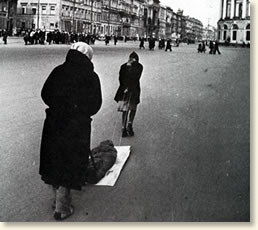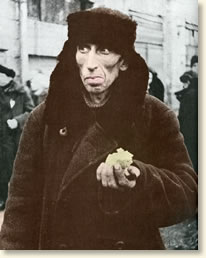|
The Siege of Leningrad, 1941 - 1944
It was horrific. The siege of Leningrad (the modern-day St. Petersburg) lasted almost two and one-half years and cost the lives of an estimated 1,000,000 city residents. It began on September 8, 1941 when German troops completed their encirclement of the city. As his blitzkrieg rushed towards Moscow, Hitler made the strategic decision to bypass Leningrad and strangle the city into submission rather than commit valuable resources to attacking it directly.
 |
A victim of the siege
is dragged to a cemetery |
Hunger and cold became the city's greatest enemies. By the end of September, the city's oil and coal supplies were exhausted. This meant that the city was without any central heating. As the brutal Russian winter approached, water pipes froze and broke, denying the residents drinking water.
Food supplies were cut. By November, individual rations were lowered to 1/3 of the daily amount needed by an adult. The city's population of dogs, cats, horses, rats and crows disappeared as they became the main course on many dinner tables. Reports of cannibalism began to appear. Thousands died - an estimated 11,000 in November increasing to 53,000 in December. The frozen earth meant their bodies could not be buried. Corpses accumulated in the city's streets, parks and other open areas.
To compound the misery, the Germans incessantly bombarded the city with air and artillery attacks.
The Russian winter had one positive effect. It froze Lake Ladoga to the city's east and created a life-line over which caravans of trucks hauled a meager amount of food and supplies. It also provided an evacuation route for thousands of the city's weak and elderly. The loss of population through death and evacuation decreased the strain on the remaining inhabitants. Food rations were increased and the city's situation stabilized. By January 1944, the Red Army had pushed the German army beyond Leningrad allowing the city to celebrate the end of its siege.
Alexander Werth was a correspondent for the London Sunday Times and the BBC who accompanied the Soviet troops as they pushed the Germans from their soil. He interviewed a number of Leningrad residents shortly after the siege was lifted:
"The Astoria looks like a hotel now, but you should have seen it during the famine! It was turned into a hospital - just hell. They used to bring here all sorts of people, mostly intellectuals, who were dying of hunger. Gave them vitamin tablets, tried to pep them up a bit. But a lot of them were too far gone, and died almost the moment they got here. I know what it is to be hungry. I was so weak I could, hardly walk. Had to use a walking stick to support me. My home is only mile away, in the Sadovaya...I'd have to stop and sit down every hundred yards...Took me sometimes over an hour to get home...
You don't know what it was like. You just stepped over corpses in the street and on the stairs. You simply stopped taking any. It was no use worrying. Terrible things used to happen. Some people went quite insane with hunger. And the practice of hiding the dead somewhere in the house and using their ration cards was very common indeed. There were so many people dying all over the place authorities couldn't keep track of all the deaths... You should have seen me in February 1942. Oh, Lord, I looked funny! My weight dropped from seventy kilos to forty kilos in four months! Now I'm back to sixty-two - feeling quite plump..."
"We went on with this blueprint work right through the winter 1941-2. . . It was a blessing for us architects. The best medicine that could have been given us during the famine. The moral effect is when a hungry man knows he's got a useful job of work to do. . But there's no doubt about it: a worker stands up better to hardships than an intellectual.
A lot of our people stopped shaving - the first sign man going to pieces. . . Most of these people pulled themselves together when they were given work. But on the whole men collapsed more easily than women, and at first the death-rate was highest among men. However, those who survived the worst period of the famine finally survived. The women felt the after-effects more seriously than the men. Many died in the spring, when the worst was already over. The famine had peculiar physical effects on people. Women were so run down that they stopped menstruating...
 |
A starving man holds
his daily ration in his hand. |
So many people died we had to bury them without coffins. People had their feelings blunted and never seemed to weep at the burials...It was all done in complete silence, without any display of emotion. When things began to improve the first signs were that women began to put rouge and lipstick on pale, skinny faces. Yes, we lived through hell right enough; but you should have been here the day the blockade was broken - people in the street wept for joy, and strangers fell round each others' necks. Now life is almost normal. There is this shelling, of course, and people get killed, but life has become valuable again."
"In those days there was something in a man's face which told you that he would die within the next twenty-four hours...I have lived in Leningrad all my life, and I also have my parents here.
They are old people, and during those famine months I had to give them half my officer's ration, or they would certainly have died. As a staff officer I was naturally, and quite rightly, getting considerably less than the people at the front: 250 grams a day instead of 350.
I shall always remember how I'd walk every day from my house near the Tauris Garden to my work in the centre of the city, a matter of two or three kilometres. I'd walk for a-while, and then sit down for a rest. Many a time I saw a man suddenly collapse on the snow. There was nothing I could do. One just walked on. And, on the way back, I would see a vague human form covered with snow on the spot where, in the morning, I had seen a man fall down.
One didn't worry; what was the good? People didn't wash for weeks; there were no bath houses and no fuel. But at least people were urged to shave. And during that winter I don't think I ever saw a person smile. It was frightful. And yet there was a kind of inner discipline that made people carry on. A new code of manners was evolved by the hungry people. They carefully avoided talking about food. I remember spending a very hungry evening with an old boy from the Radio Committee. He nearly drove me crazy - he would talk all evening about Kant and Hegel. Yet we never lost heart. The Battle of Moscow gave us complete confidence that it would be all right in the end. But what a change all the same when February came and the Ice Road began to function properly!"
References:
Werth, Alexander, Russia at War 1941-1945 (1964); Salisbury, Harrison The 900 Days; the Siege of Leningrad (1969).
How To Cite This Article:
"The Siege of Leningrad, 1941 - 1944" EyeWitness to History, www.eyewitnesstohistory.com (2006).
|






